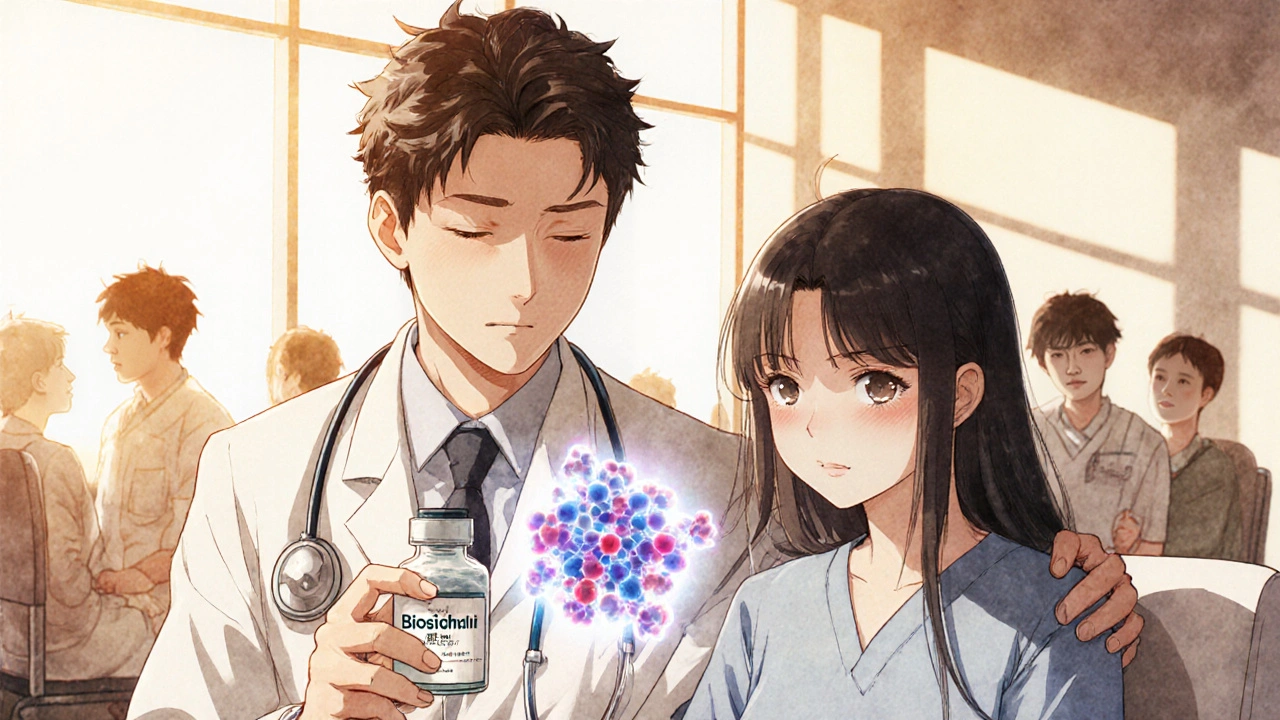When your doctor says, "We’re switching you to a biosimilar," it’s natural to feel uneasy. You’ve been on Humira, Enbrel, or Remicade for years. It works. You know how your body reacts. Now, someone’s asking you to try something new - and cheaper. But is it safe? Is it the same? What if it doesn’t work? These aren’t just questions. They’re fears rooted in real experiences, misinformation, and a system that hasn’t done enough to explain what biosimilars really are.
What Exactly Is a Biosimilar?
A biosimilar isn’t a generic. That’s the first thing you need to understand. Generics are exact chemical copies of small-molecule drugs - like aspirin or metformin. They’re made in labs using predictable chemical reactions. Biosimilars are different. They’re made from living cells - yeast, bacteria, or mammalian cells - and are designed to be highly similar to a reference biologic drug, like Humira or Enbrel. They’re not identical, but they’re not different in any way that matters for your health.
The FDA requires biosimilars to go through more than 100 tests before approval. They look at the molecule’s structure, how it behaves in the body, how it binds to targets, and even how your immune system reacts to it. Then they test it in clinical trials - usually with hundreds of patients - to prove there are no meaningful differences in safety, effectiveness, or side effects compared to the original. The first U.S. biosimilar, Zarxio, was approved in 2015. Since then, 74 have been approved as of April 2025.
That’s not a small number. It’s a major shift. And yet, fewer than 10% of patients prescribed a biologic are actually switched to a biosimilar. Why? Because most people don’t understand what they are - or worse, they’ve been told they’re inferior.
Why Are Patients So Hesitant?
One survey found that only 31% of patients with chronic conditions even know what biosimilars are. Meanwhile, 79% worry they won’t work as well. Sixty-three percent fear new or worse side effects. And it’s not just patients. Doctors, too, are unsure. Only about 70% of healthcare providers fully understand that biosimilars are just as safe and effective.
Part of the problem? Bad experiences. On Reddit, a user named ChronicPainPatient87 wrote: "My doctor switched me to a biosimilar without telling me. I had a flare-up. Now I’m terrified to switch again." That story isn’t rare. In some cases, patients were switched without consent, without explanation, or without monitoring. That’s not how biosimilars should be introduced. It’s a breach of trust - and it fuels fear.
Another issue? Cost doesn’t always reach the patient. Biosimilars save the system billions - $56 billion over the past decade. But in many cases, insurance plans don’t pass those savings on. A study of seven biologics found that out-of-pocket costs didn’t drop after biosimilars entered the market. Patients paid the same for the biosimilar as they did for the brand-name drug. So why switch? If you’re not saving money, and you’re scared of something new, the answer is simple: you don’t.
Biosimilars vs Generics: The Big Difference
People hear "similar to a brand drug" and think, "Oh, like generics." But the comparison doesn’t hold up. Generics are chemically identical. Biosimilars are biologically similar - and that’s a huge distinction.
Think of it this way: a generic is like copying a photograph. A biosimilar is like recreating a painting using the same artist’s tools, brushes, and techniques - but with slightly different pigments. The result looks nearly the same, feels the same, and does the same job. But it’s not a photocopy. It’s a hand-painted replica made by a different studio.
Because of this complexity, developing a biosimilar takes 8-10 years and costs $100-250 million. A generic? Three to four years and $2-3 million. That’s why there are thousands of generics but only 74 biosimilars - and why companies are slow to make them.
But here’s the good news: once approved, biosimilars perform just like the originals. Real-world data from over 200,000 patients shows no increased risk of side effects, no loss of effectiveness, and no higher rate of immune reactions. The FDA, the European Medicines Agency, and the World Health Organization all agree: biosimilars are safe.

Why Aren’t More People Using Them?
It’s not just about fear. It’s about how the system works.
Pharmacy benefit managers (PBMs) - the middlemen who control drug coverage - often push patients toward biosimilars, but not always for the right reasons. In April 2024, CVS removed Humira from most commercial formularies. That forced patients onto biosimilars. And while the average cost of biologics dropped by 2.3 percentage points, patient satisfaction dropped by 15%. Why? Because patients felt forced. No conversation. No choice. No education.
Meanwhile, drugmakers use "pay-for-delay" tactics to block biosimilars. Some pay biosimilar companies to delay their launch. On average, this delays access by 18 months. That’s not competition - that’s control.
And then there’s the "biosimilar void." Even though 27% of high-selling biologics (over $500 million in annual sales) have no biosimilar at all, no one’s rushing to make them. Why? Because the approval process is still long, expensive, and uncertain - even with new FDA guidance in 2024 that reduces the need for extra clinical trials.
How to Build Trust: What Patients Need to Know
Here’s the truth: biosimilars work. They’ve been used safely in Europe for over 15 years. In the U.S., they’ve been on the market for nearly a decade. And the data is clear - no drop in effectiveness, no rise in serious side effects.
But trust doesn’t come from a brochure. It comes from conversation.
Here’s what works:
- Explain it simply: "This is not a new drug. It’s a copy of the one you’ve been taking - made with the same science, tested the same way, and proven to work just as well. The only difference? It costs less for the system, and if we do this right, it could cost less for you too."
- Involve the patient: Don’t switch without asking. Say: "We have a lower-cost option that’s just as safe. Would you like to learn more?"
- Track outcomes: Use real-world data. Check your disease markers - CRP, ESR, joint swelling - before and after the switch. If your numbers stay the same, that’s proof it’s working.
- Address the nocebo effect: If you tell someone they might feel worse, they probably will. Don’t frame biosimilars as "second best." Frame them as "equally good, more affordable."
One study found that when patients received a detailed, visual explanation of how biosimilars are made and tested, their willingness to try one jumped from 38% to 72%. That’s not magic. That’s clarity.

What’s Next? The Road to Wider Adoption
By 2030, nearly 118 biologic drugs - worth $232 billion - will lose patent protection. That’s a massive opportunity. If biosimilars reach 50% adoption, we could save $300 billion by 2030. That means more people can get life-changing treatments for rheumatoid arthritis, Crohn’s disease, cancer, and diabetes.
But it won’t happen by accident. It needs:
- Clearer rules: The FDA wants all biosimilars to be "interchangeable" - meaning pharmacists can switch them without asking the doctor. That’s a good step, but only if patients are educated.
- Transparency: Insurance plans must pass savings to patients. If a biosimilar costs 30% less, your copay should drop too.
- Provider training: Doctors need to feel confident explaining biosimilars. They’re not just prescribing a drug - they’re rebuilding trust.
- Real-world evidence: More studies tracking patient outcomes over time. The more data we have, the less fear there will be.
Some patients will still say no. And that’s okay. But those who are hesitant - not opposed - need better information. Not marketing. Not pressure. Just facts, delivered with honesty and care.
What You Can Do Right Now
If you’re on a biologic and your doctor suggests a biosimilar:
- Ask: "Is this biosimilar FDA-approved?" (All are.)
- Ask: "Has it been used in other patients? What were the results?"
- Ask: "Will my out-of-pocket cost change?"
- Ask: "Can we monitor my condition closely after the switch?"
- Ask: "Can I go back to the original if I need to?"
And if you’re a caregiver, advocate, or patient leader: share your story. Talk about your experience. Tell others that biosimilars aren’t a gamble - they’re a proven, safe, and more affordable option. The more people hear real stories, the less scary they become.
Change doesn’t come from legislation alone. It comes from conversation. From trust. From knowing you’re not being sold something cheaper - you’re being offered the same care, with less financial burden.
Are biosimilars safe?
Yes. Biosimilars are rigorously tested by the FDA to prove they have no clinically meaningful differences in safety, purity, or effectiveness compared to the original biologic. Over 74 are approved in the U.S., and real-world data from hundreds of thousands of patients confirms they work just as well with no increase in side effects.
Are biosimilars the same as generics?
No. Generics are exact chemical copies of small-molecule drugs. Biosimilars are made from living cells and are "highly similar" to complex biologic drugs, but not identical. They require much more testing - including clinical trials - to prove they work the same way in the body.
Why don’t biosimilars cost less for me at the pharmacy?
Even though biosimilars save the healthcare system billions, insurance plans and pharmacy benefit managers don’t always pass those savings to patients. In some cases, your copay stays the same even after switching. Ask your provider or insurer: "Will my out-of-pocket cost go down?" If not, that’s something to push back on.
Can I switch back to the original drug if the biosimilar doesn’t work?
Yes. There’s no rule that locks you into a biosimilar. If you experience a flare-up, new side effects, or feel worse, your doctor can switch you back. Always monitor your symptoms and report changes. Your health comes first.
How do I know if a biosimilar is right for me?
Talk to your doctor. Ask if your condition has been studied with biosimilars. Check if your disease markers (like CRP or ESR) can be tracked before and after the switch. And make sure you’re part of the decision - not just told about it. If you’re comfortable with the explanation and have a plan to monitor your response, it’s likely a good option.
Final Thought
Biosimilars aren’t a compromise. They’re a breakthrough. They’re the result of years of science, billions in investment, and a system trying to make life-saving treatments more accessible. But science alone won’t win trust. People will. When patients are heard, informed, and included - not switched without consent - adoption grows. And when adoption grows, more people get the care they need, without being crushed by cost.






edgar popa
November 14, 2025 AT 08:08Eve Miller
November 14, 2025 AT 09:11Chrisna Bronkhorst
November 15, 2025 AT 20:51Amie Wilde
November 15, 2025 AT 21:52Gary Hattis
November 16, 2025 AT 23:32Esperanza Decor
November 18, 2025 AT 07:54Deepa Lakshminarasimhan
November 19, 2025 AT 22:15Erica Cruz
November 20, 2025 AT 00:58Johnson Abraham
November 20, 2025 AT 07:44Shante Ajadeen
November 20, 2025 AT 12:54dace yates
November 22, 2025 AT 02:23Danae Miley
November 23, 2025 AT 09:40Charles Lewis
November 24, 2025 AT 08:22Renee Ruth
November 26, 2025 AT 05:57